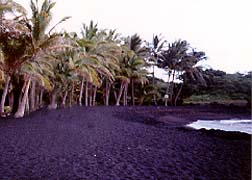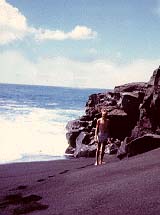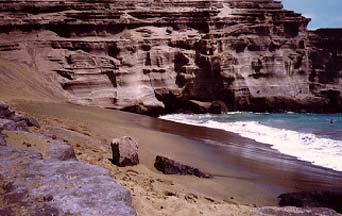Honokohau beach, is now Kaloko-Honokohau National Historical Park. You may swim in the Pacific Ocean, relax to the sounds of wild birds, watch ducks on the pond, and relish the scenery of Hualualai Mountain. There is no lifeguard. To get there, take route 19 north from Kailua-Kona for three miles and turn left on the access road to Honokohau Harbor. Then take the first right turn which should take you around to the dry dock area. Next continue to the end of the pavement and park anywhere along there. Look for the signs of a path between the large lava boulders. Once over the boulders continue on the path until you see the ocean. Then follow the shore to the right to get to the beach area.

Punaluu
is a good swimming beach, but watch for the current just outside the bay because
it can be dangerous. There is a small curio shop there which sells post cards,
shell leis, and other tourist goodies. The soothing massaging feeling
of the lava granules under foot is an experience everyone should enjoy.

Kamoamoa, Black Sand Beach.
Kamoamoa
is now history. A few years ago it was covered with a new lava flow. It was located
in the most popular spot on the island, the Volcano
National Park. The black lava granules, which covered the beach when caught
by the sunlight, looked iridescent. I would like to take you on a virtual field
trip to the park. So make yourself comfortable; we have plenty of time. Now, you're
ready to go to the Virtual
Field Trips web site, where you may find spectacular photos of the park.

Puu
Mahana, Green Sand Beach, is located in the Kau' district. It is primarily located
on the slopes of Mauna Loa, the world's largest and most massive active volcano
on the southwestern part of the island. To get to this beach, one must either
use a four wheel drive or hike six miles from South Point, Ka Lae, the southern
most tip of the United States.
Volcanologist, Steve Mattox of University
of North Dakota gives this explanation for such a spectacular one of a kind place.
"The beach formed by the erosion and concentration of olivine crystals derived from the surrounding cone. The volcanic cone is Puu Mahana and it is a tuff ring (a type of volcano formed by the interaction of magma and shallow groundwater). The cone is associated with the Southwest Rift Zone of Mauna Loa (although the cone is not right on the rift). Mauna Loa flow can contain abundant olivine crystals. As ocean waves crashed against the coast they wore away at the cone and made a small bay along the coast. The waves also removed the lighter grains of sand (made of volcanic ash) leaving the denser olivine crystals behind to form the beach. I do not know of another green sand beach. Olivine is common in basalt lava. A few crystals might be found in some andesite lava. It is never found in dacite and rhyolite lava."
For information about the Hawaii Islands, visit:
I hope you have enjoyed your visit.
Mahalo
Regina